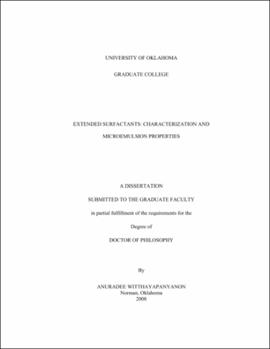| dc.description.abstract | Extended surfactants are surfactants with intermediate polarity groups, such as polypropylene oxide (PO) and polyethylene oxide (EO), inserted between the hydrophilic head and the hydrocarbon tail. With this unique molecular structure, extended surfactants provide an enhanced interaction with both oil and water phases. This results in microemulsion formation with desirable low interfacial tension (IFT) and high solubilization properties, especially for highly hydrophobic oils and vegetable oils. Such formulations have numerous potential applications in enhanced subsurface remediation, drug delivery, and detergency. However, due to the limited amount of information available on these recently developed surfactants, there is no easy and adequate technique to guide the formulation selection process and microemulsion characteristics for extended surfactant systems. In addition to the challenge in characterization, extended surfactant-based microemulsions also struggle with their slow kinetics. Therefore this present work seeks to characterize extended surfactant hydrophilicity/lipophilicity, and at the same time, evaluate both equilibrium and kinetic properties of extended surfactant-based microemulsions. The thermodynamically derived model known as hydrophilic-lipophilic deviation (HLD) approach used in combination with microemulsion phase behavior was proposed as a simple, yet convenient tool for characterizing extended surfactant behavior and predicting the optimal conditions for microemulsion systems. To our knowledge, this is the first report of the extended surfactant hydrophilicity/lipophilicity index and interfacial morphology of the extended surfactant membranes (i.e. characteristic length and interfacial rigidity). The findings of this study not only emphasize the important role of inserting PO and EO groups on the hydrophilic-lipophilic nature of extended surfactants, but also demonstrate the impact these intermediate functional groups have on both equilibrium and dynamic microemulsion properties. | |
